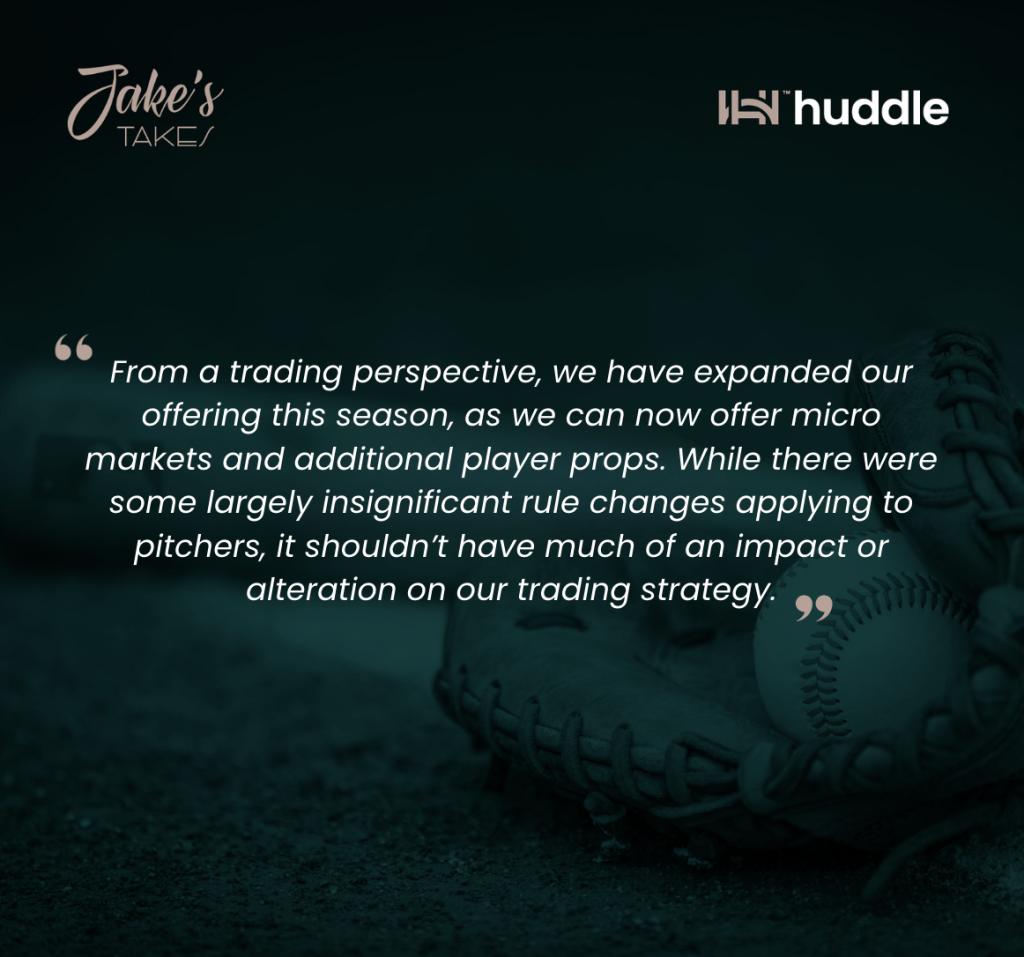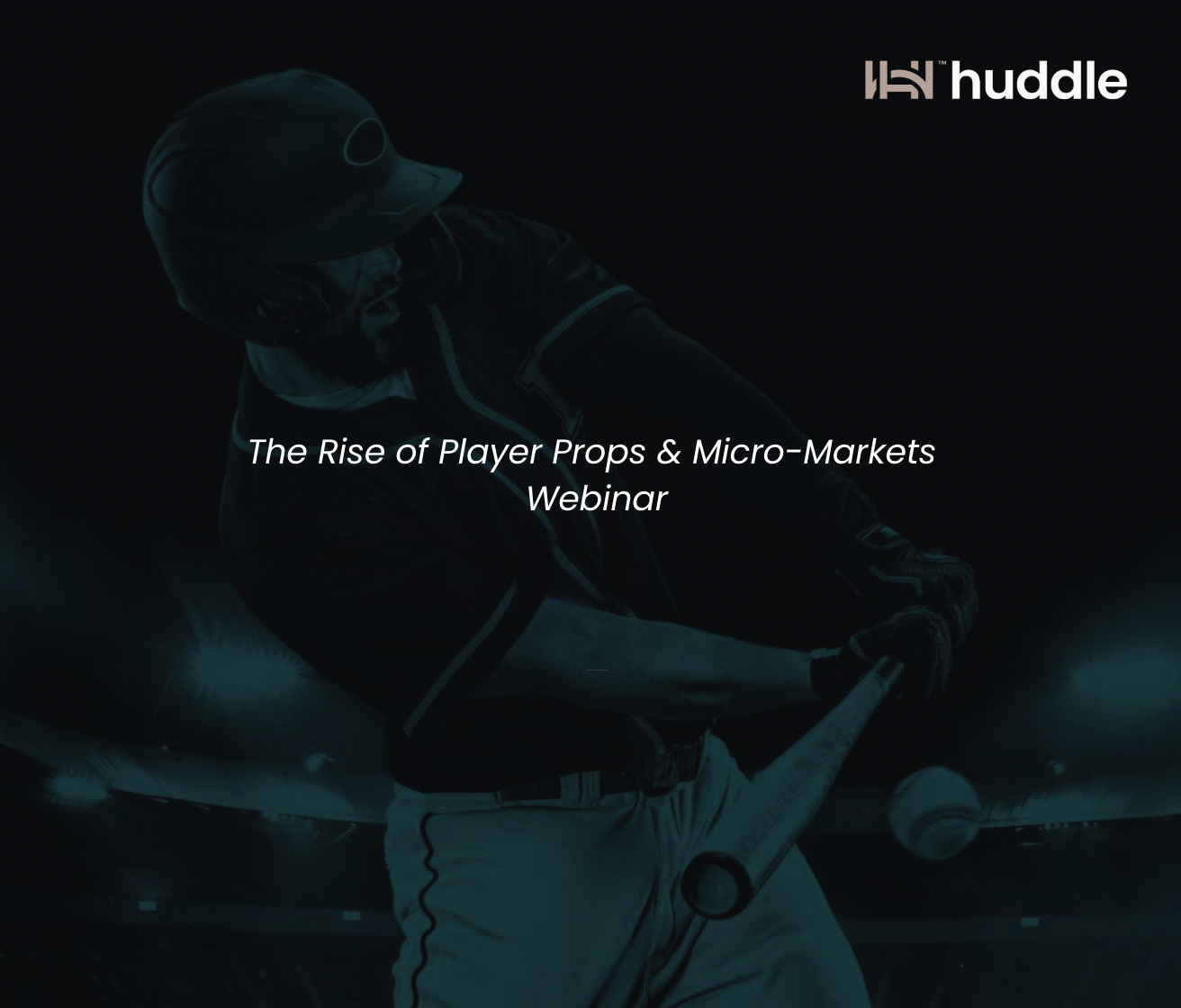
Inside Huddle’s Game Plan: A Q&A on MLB Betting Strategies for 2024 with Huddle’s VP of Trading
Blog
Inside Huddle’s Game Plan: A Q&A on MLB Betting Strategies for 2024 with Huddle’s VP of Trading
We are back with the latest Jake's Takes, this time with MLB taking the centre stage!
While the 2024 Major League Baseball (MLB) season officially began last week with a two-game mini-series between the San Diego Padres and the Los Angeles Dodgers, Thursday March 28th marked the opening day for every other MLB team.
Before I delve into my early-season predictions in next week’s article, I wanted to chat with Huddle’s VP of Trading, Paul Moen, regarding Huddle’s spectacular baseball product. If you’re a bettor – no matter if you’re a casual or a sharp – this is something you’ll enjoy.
Jake: MLB season kicked off on Thursday. Obviously one of the biggest elements of betting comes down to team performance, especially for casual bettors. What factors do you consider when projecting each team’s performance for the upcoming MLB season?
Paul: At Huddle, we utilize a player-based model for MLB that is tried and true, therefore team performance is not something we need to project. Given this a player-based model, it is critical that team lineups are accurate and complete for us to maximize the experience for the end-user.
Jake: So you would say incorporating player statistics, historical data and perhaps team dynamics into your projections is a better way to say what you do?
Paul: Mostly yes. Historical data makes up the core foundation of our player level projections. When uncertainty exists with our projections, such as when a pitcher is trying to battle through an injury, traders rely on their domain knowledge of the sport combined with a reasonable sample of historical data in order to generate lines. For players with a smaller sample size (like a lack of meaningful historical data), we use subjective analysis to come up with a player rating, compared to someone deemed a replacement level player.

Jake: Sounds complex, though I’m sure it is decidedly less so. Okay, how about you walk me through the process of generating preseason and in-season projects for MLB games.
Paul: Like I said earlier, generating projections is a continuous process that is monitored and updated on a real-time basis using our player-based MLB model. For pitchers, it’s more valuable to utilize a precise projected pitch count for both pregame and live trading. If a pitcher gets injured during the game, one of our traders will quickly adjust the injured pitcher’s pitch count, and also set up the bullpen pitcher as the next pitcher to come into the game.
Jake: Okay, and the same / similar process for batters?
Paul: For field players and hitters (as we designate them), a trader may notice a player becomes injured and must make a timely adjustment to the lineup by removing the injured player and updating the lineup with the newly substituted player. Both of these situations create new game states and our team at Huddle is able to update / run new simulations to generate updated market pricing in real time.
Jake: I assume ballpark factors are something that you have to take into account as well?
Paul: Absolutely. A major component of trading involves analyzing air density and wind direction, as each setting is unique. Without giving away too much, traders have a keen eye and are aware that certain colors, even backgrounds, may impact both pitchers and hitters.
Jake: Interesting! And naturally, I assume ballpark factors are more subject to in-season change as the weather changes.
Paul: Bingo. Certain ballpark factors change as locations go from being cold and wet in April to warm and dry by June and July. All of that is captured in the model’s inputs and parameters.
Jake: Looking at the end user’s side of things, how do you balance demand from people (bettors) with setting fair and profitable odds for MLB games? You often see upset people posting on X (formerly Twitter) about such inefficiencies or issues.
Paul: Balancing demand from bettors with setting fair and profitable odds is a discipline learned over time. I trade and live by the adage, “Take a bet and move the line.” In addition to taking a bet, a trader will monitor an odds screen to compare internal pricing to the rest of the market. Therefore, you have a delicate balance of trusting in your model’s projections while also considering the current market pricing for a given market.
Jake: On the risk side, are there any unique strategies you employ to mitigate risk and ensure profitability?
Paul: It starts with empowering the trader with controls over changing limits. This is a critical strategy. Let me present two scenarios for you.
First, consider it is Wednesday night at 7:00 pm local time and pregame lines are sent overnight (or in the early morning of a game day). A significant amount of uncertainty exists, as there is a lot of time between “now” and the actual start of the game. It may be unknown that Shohei Ohtani spent all of Wednesday night at the sportsbook and had a slip/fall accident in the bathroom, where he injured his back and right elbow. I know, this situation is ludicrous, but the point I’m trying to drive home is that a trader should offer lower limits for instances when there is uncertainty and lineups are not confirmed.
Second, consider it’s now game day at 5:10 pm local time. Official lineups should have been released by this point in time. A trader will ensure lineups are accurate in the player-based model and can then compare internal pricing to the market. When uncertainty is reduced, a trader should then feel comfortable raising limits.
Profile your bettors. If I have profiled them, I can use their information to adjust my line accordingly.
Jake: Thank you for those scenarios, and the Shohei shoutout is too good – I’m sure some people here have very interesting opinions on him. My last question is simple: how does this MLB season differ from last season from a trading perspective?
Paul: From a trading perspective, we have expanded our offering this season, as we can now offer micro markets and additional player props. While there were some largely insignificant rule changes applying to pitchers, it shouldn’t have much of an impact or alteration on our trading strategy.
Subscribe to our weekly newsletter and get the latest insights straight to your inbox!















